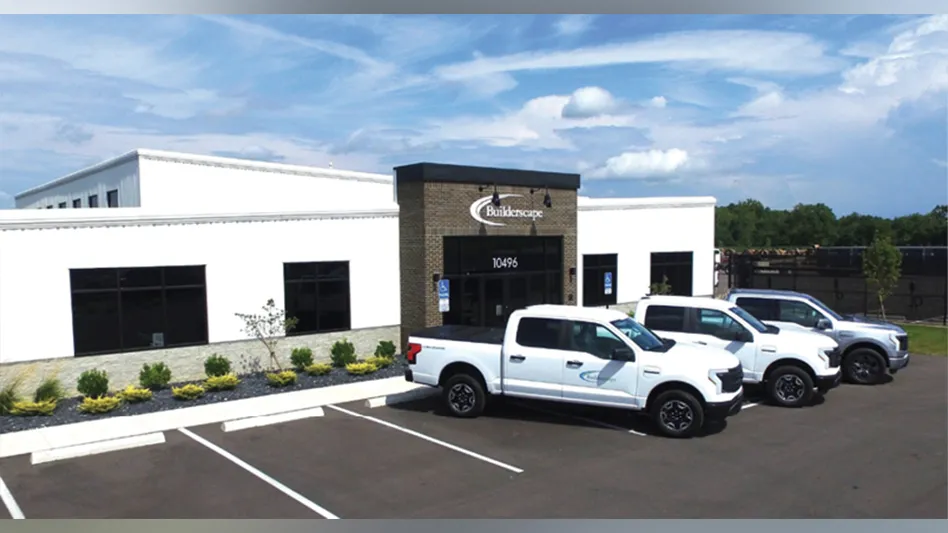
After reports of severe damage to conifers and other trees from Maryland to Minnesota, DuPont Professional Products is cautioning LCOs not to use the new post-emergent broadleaf weed control product in areas where Norway spruce or white pine trees are located.
The company released Imprelis in early spring, giving LCOs a low-volume option that by all accounts gave solid control of a wide range of weeds, including hard-to-eradicate species like ground ivy and wild violet.
Imprelis herbicide controls a wide range of broadleaf weeds with a new active ingredient – aptexor – and a new subclass of the carboxylic acid herbicides. The new AI allows LCOs to control weeds with much smaller applications of product: 4.5 fluid ounces (or 0.07 lbs.) per acre. Read more about the launch of Imprelis, and the testing it underwent, here.
But since Memorial Day, applicators and university researchers in the Northeast and Midwest have been reporting curling needles, severe browning and dieback in trees near turf that had been treated with Imprelis.
University and state researchers from Michigan and Indiana say they’ve seen symptoms in evergreens, more specifically conifers, and mainly Norway spruce and white pine trees.
“On the spruces, what we see is the current year’s growth. So the newly emerging shoots will brown up or wilt, and then you sometimes get a twisting appearance to them,” said Bert Cregg, associate professor of horticulture and forestry at Michigan State University.
“Largely based on photos that have been sent to me, it’s almost the whole tree is affected. Some of the other things we see with spruces often are affecting individual branches, but this is a pretty uniform kind of damage to the tree.”
In a June 17 letter to Imprelis customers, which you can read here, DuPont said it is investigating the incidents, and has found them to have the following variables in common:
• A majority of the reports involve Norway spruce or white pine.
• In most cases, Imprelis was not applied alone, but in a mixture with other herbicides, either pre-emergent, post-emergent and/or with a liquid fertilizer.
• Some reports indicate there may have been errors in use rates, mixing practices and/or applications to exposed roots, or the tree.
The company also stressed that the majority of applications have not resulted in these symptoms.
"As a precaution, until we can more fully understand the circumstances, and whether Imprelis may have contributed to the observed symptoms, do not apply Imprelis where Norway spruce or white pine are present on, or in close proximity to, the property to be treated,” the letter states.
“Additionally, when applying Imprelis, be careful that no spray treatment, drift or runoff occurs that could make contact with trees, shrubs and other desirable plants, and stay well away from exposed roots and the root zone of trees and shrubs. Consult a certified arborist if you are uncertain about the root zone of specific tree species,” it continues.
What LCOs are saying. Bob Andrews, owner of The Greenskeeper in Carmel, Ind., said he has made about 2,000 applications of Imprelis and has had about eight cases that he thinks will be verified as Imprelis damage.
Andrews, who is also executive director of the Indiana Lawn and Landscape Association, added that he didn’t really notice the problem from applications made between mid-April and mid-May until his area had a couple of mid-90 degree days in the second week of June.
“I’ve been a lawn care operator for 30 years and I have never seen anything quite as odd as this,” he said. “It’s very spotty and you may have five or six white pine trees in a bunch and one of them is affected and the others are just fine. Some of the damage is at the very top and it’s all limited to new growth. And we can say that fairly certainly.”
In some cases, Andrews said there have been trees where one side faces a fence and the other side faces a lawn, and the side facing the lawn is the only part damaged.
Andrews said he’s going to apply a light coat of surface fertilization around the damaged trees, and will monitor them every other week until the problem is resolved.
“I frankly don’t think any of these will die,” he said.
Mark Utendorf, owner of Emerald Lawn Care in Arlington Heights, Ill., said he has seen symptoms like distorted new growth on pine and yew trees that are consistent with other reports. He received an email from The Brickman Group instructing its lawn care subcontractors to stop applying Imprelis because it could be linked to the damage.
“My heart fell through the floor,” said Utendorf, who was part of advance testing of the product before it hit the market. He said he still wants to use the product because of how well it works controlling weeds.
Andrews was also impressed with the product, but has taken it out of his tank mix.
“I feel bad for DuPont,” Andrews says. “It’s a hell of a product. I’ve never seen a product work as well on hard-to-control weeds.”
Utendorf still is not sure of the extent of the damage and won’t for at least a season, but to this point has not seen any trees die.
“We’re not out of the woods by any stretch, and won’t be for another month,” Utendorf said.
And while he’s upset, he still supports DuPont.
Utendorf said that the product may become a scapegoat for a lot of problems. “The scary thing for us and DuPont is that now, anybody that sees anything is going to blame Imprelis.”
While the Office of the Indiana State Chemist hasn’t linked Imprelis specifically to the complaints it’s receiving, Joe Becovitz, pesticide program specialist, said Imprelis has been used on lawns in cases where the symptoms are popping up. He said the office has received 40 complaints – a large number for any one type of situation.
“We’re seeing things that look like growth regulator type of injury where you’re seeing the twisting and curling of the new growth,” he said. “The new growth eventually turns brown and looks droopy. It seems to start on the tips of the branches. Sometimes it starts high in the tree, the top of the tree, and works its way down, but not always.”
More questions than answers. Cregg said it’s too early to tell what the damage means for trees’ long-term health, but, with the level of dieback he has seen, the trees are going to look pretty deformed for the foreseeable future.
“What’s going to happen is if those new buds are killed, those new shoots are killed, it’s going to be difficult for the tree to produce new buds on those shoots, so it will produce buds on the older shoots and sprout out from there,” Cregg said. “The trees may not be dead, but as far as the aesthetic for a landscape tree, it would be pretty difficult for a homeowner to want to keep that tree around.”
The symptoms are showing up rather dramatically in just a matter of weeks after application, Cregg said. He added he has only heard about and seen the symptoms in trees perhaps because smaller plants and shrubs do not have the lateral root extension that trees have.
“What appears to be going on is (LCOs are) treating the turf, but conifer roots especially for spruces, they tend to have very shallow, extensive root systems, so they have roots that extend well beyond their drip line,” Cregg said. “The applicator may be thinking, ‘I stayed away from the drip line, I may be fine,’ but in fact when you get into it there are a lot of roots out there underneath the turf that then pick up the herbicide.”
What to do. Researchers say lawn care operators and homeowners should wait and see how the symptoms progress through the season. Because the active ingredient in Imprelis is new, there’s little historical information available.
Cregg recommends LCOs heavily irrigate the area to flush any remaining material through. On the other hand, if the tree is already stressed and then overwatered, there’s potential for more problems. In some cases, one might try to remove the affected soil and replace with clean topsoil, but should be careful about the potential of removing too many roots in the process. An air spade could be used to remove the affected soil without damaging roots.
If symptoms such as those described do appear contact your state’s department of agriculture, extension office and landscaping association, or your local DuPont representative.
Becovitz said the Office of the Indiana State Chemist is in the early stages of its investigative process and is being assisted by Purdue University’s diagnostic lab.
The Minnesota Department of Agriculture is going to put out a survey to all the lawn care operators in the state asking a series of questions so that we can start to identify who’s used what, what damages are they seeing and how much of a property is damaged – those sorts of question, said Brian Horgan, assistant professor and extension turfgrass specialist at the University of Minnesota,
“This one is complicated by the fact that this is a new active ingredient, and so we have never – and I think you’re going to find most of the state labs don’t have any real experience for the method of finding this particular active ingredient in soil, in plant tissue,” Becovitz said. “So it’s going to be a learning experience for us.”
Cregg added. “We just know so little about this product that it’s really hard to tell people what to do. You don’t want to make the situation worse.”
Keep checking www.lawnandlandscape.com for updates to this developing story.
What are state researchers saying?
Here is a round-up of some of the latest news:
Imprelis herbicide may injure evergreens
What to do with Imprelis-affected trees





